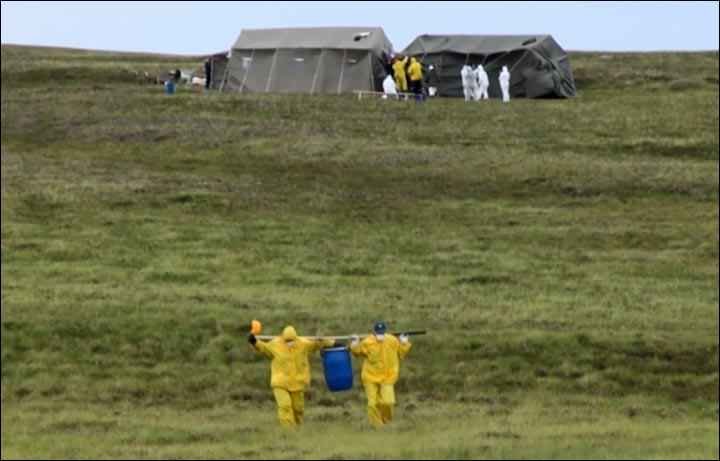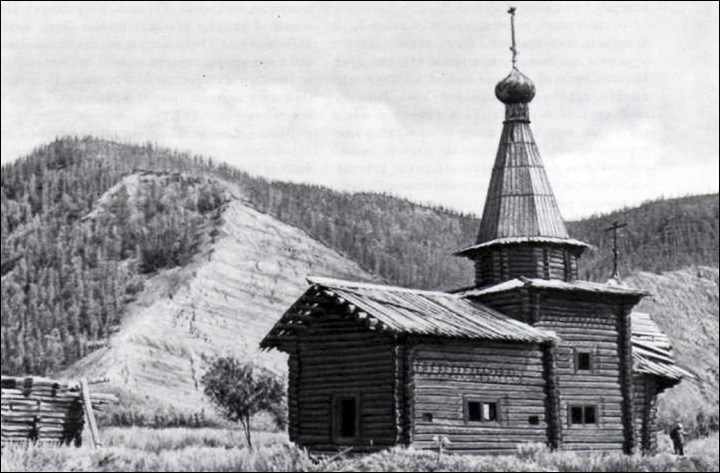
Currently 24 people are in hospital in Salekhard, on the Arctic Circle, after contracting potentially lethal anthrax from unfrozen reindeer or human burial sites, but scientists say this is far from the only threat as climate change grips Siberia.
Anthrax spores are already 'on the loose" on the Yamal peninsula, according to one scientist, and this should act as a warning of the real risk of a return of eradicated smallpox from melting permafrost which allows the erosion of river banks at sites where victims were buried, said another.
'Back in the 1890s, there occurred a major epidemic of smallpox,' said Boris Kershengolts, deputy director for research at the Institute for Biological Problems of Cryolithozone, of the Siberian Branch of the Academy of Sciences.
'There was a town where up to 40% of the population died. Naturally, the bodies were buried under the upper layer of permafrost soil, on the bank of the Kolyma River. Now, a little more than 100 years later, Kolyma's floodwaters have started eroding the banks.'
Experts from the Novosibirsk-based Virology and Biotechnology Centre had conducted research in the area, said Sergey Netesov, chief of the bionanotechnology, microbiology and virology laboratory at the natural sciences department of Novosibirsk State University.
The corpses they studied bore sores that looked like those smallpox might cause, he told an intriguing and troubling TASS video conference involving multi-disciplinary experts on the implications of the outbreak of anthrax on the Yamal peninsula in northern Siberia.
While the virus itself was not found, some fragments of its DNA were noted. 'This type of research should go on,' he urged. 'Examining deeper burials might help clear up the situation.'
Yamal and the anthrax outbreak now underway - the first for 75 years - should act as a warning, he said, calling for a more serious attitude to preventive measures against dangerous infections.
While the number of people hospitalised with anthrax has halved since Friday, two dozen people remain infected by the disease which also killed more than 2,300 reindeer.
'The Yamal outbreak is a reason enough to finance research into the diagnostics and prevention of exceptionally dangerous infections,' he said.
He explained there are there are thousands of such cattle graves across Russia and many of them are inside the Arctic Circle, which last month - July - experienced the warmest temperatures on record rising to 35C.
Anthrax is a disease that has been known for centuries and methods of effectively resisting it had been devised many decades ago in the Russian Empire, he said. The burial sites of infected household animals were fenced off to prevent relapses. But anthrax spores may last hundreds of years.
'The areas were cordoned off. This goes without saying. But my region, Novosibirsk, may see air temperatures as low as 40C below freezing in winter and (as high as) 40C degrees above zero in summer.
'In a climate like this, wooden fences don't last long. In the meantime the abandoned pastures begin to look very good and at a certain point people forget that these are no-go areas for livestock.'
Not all contaminated graveyards are known, he said. Unknown cattle graves in Russia may prove too numerous to count. In permafrost soil spores are preserved very well. In warm weather the risk is high Arctic areas may face Siberian anthrax outbreaks again and again, he said.
The depth of thawing in the Yakutia, Russia's largest region, is usually 30-to-60 centimetres, while this year it has exceeded one metre, said deputy director of the Permafrost Studies Institute, Mikhail Grigoriev.
'The rock and soil that forms the Yamal Peninsula contains much ice,' he said. 'Thawing may loosen the soil rather quickly, so the probability is high that old cattle graves may come to the surface.
'Some graves dug in the past may be just three meters deep, covered by a very thin layer of soil. The spores of the disease are now on the loose.'
Last month was the warmest ever recorded since systematic weather observations began, confirmed Sergey Semyonov, director of Russia's Global Climate Change and Ecology Institute.
Professor Valery Malinin, of the Russian State Hydrometeorological University in St Petersburg, warned that global warming in the Arctic sees climate change is three-to-four times faster than in other areas, causing such phenomena as heavy flooding.




Sounds Like Anthrax Attack Coming..
Blame it on lazy (or hyper attentive) Russia.
R.C.